Access to a variety of AP Inter 1st Year Maths 1B Model Papers and AP Inter 1st Year Maths 1B Question Paper May 2018 allows students to familiarize themselves with different question patterns.
AP Inter 1st Year Maths 1B Question Paper May 2018
Time : 3 Hours
Max. Marks : 75
Note : This question paper consists of THREE sections A, B and C.
Section – A
(10 × 2 = 20 Marks)
I. Very short answer type questions :
- Answer all the questions.
- Each question carries two marks.
Question 1.
Find the equation of the straight line passing through (-4, 5) and cutting off equal and non-zero intercepts on the co-ordinate axes.
Solution:
Let X-intercept = a
Y-intercept = a
Intercept form : \(\frac{x}{a}+\frac{y}{a}\) = 1
⇒ x + y = a
If this straight line passing through (-4, 5) then -4 + 5 = a
⇒ a = 1
∴ Required straight line equation is x + y = 1
⇒ x + y – 1 = 0
Question 2.
If the area of the triangle formed by the straight lines x = 0, y = 0 and 3x + 4y = a(a > 0) is 6, find the value of a.
Solution:
Given straight line equation is 3x + 4y = a
⇒ \(\frac{3 x}{a}+\frac{4 y}{a}\) = 1
⇒ \(\frac{x}{\frac{a}{3}}+\frac{y}{\frac{a}{4}}\) = 1
∴ X-intercept = \(\frac{a}{3}\) ;
Y-intercept = \(\frac{a}{4}\)
Given area of the triangle formed by the lines x = 0, y = 0 and 3x + 4y = a is 6 sq. units.
⇒ \(\frac{1}{2}\) (X-intercept) (Y-intercept) | = 6
⇒ \(\frac{1}{2}\) . \(\frac{a}{3}\) . \(\frac{a}{4}\) = 6
⇒ a2 = 144
⇒ a = ± 12
since a > 0
∴ a = 12
![]()
Question 3.
Show that the points (1, 2, 3) (2, 3, 1) and (3, 1, 2) form an equilateral triangle.
Solution:
Let A = (1, 2, 3)
B = (2, 3, 1)
C = (3, 1, 2)
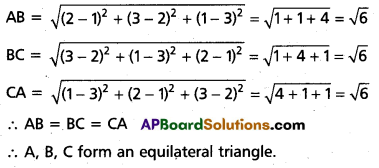
Question 4.
Find the equation of the plane passing through (1, 1, 1) and parallel to the plane x + 2y + 3z – 7 = 0.
Solution:
The equation of the plane passing through (1, 1,1) and parallel to the plane x + 2y + 3z – 7 = 0 is
a(x – x1) + b(y – y1) + c(z – z1) = 0.
⇒ 1(x – 1) + 2(y – 1) + 3(z – 1) = 0
⇒ x – 1 + 2y – 2 + 3z – 3 = 0
⇒ x + 2y + 3t – 6 = 0
Question 5.
Compute : \(\lim _{x \rightarrow 0} \frac{\sin a x}{\sin b x}\), b ≠ 0, a ≠ b.
Solution:

Question 6.
Compute : \(\lim _{x \rightarrow \infty} \frac{11 x^3-3 x+4}{13 x^3-5 x^2-7}\)
Solution:
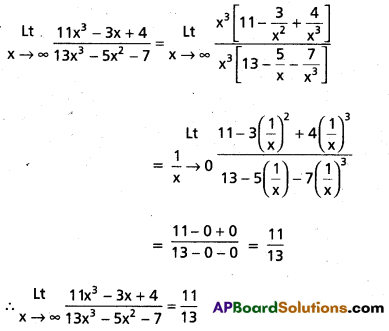
Question 7.
Find the derivative of \(\mathrm{e}^{\sin ^{-1}} x\).
Solution:

Question 8.
Find the derivative of tan-1\(\sqrt{\frac{1-\cos x}{1+\cos x}}\)
Solution:
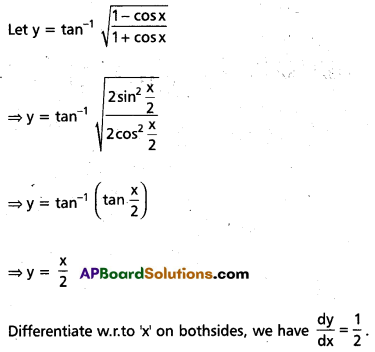
Question 9.
Find the approximate value of \(\sqrt[3]{65}\).
Solution:
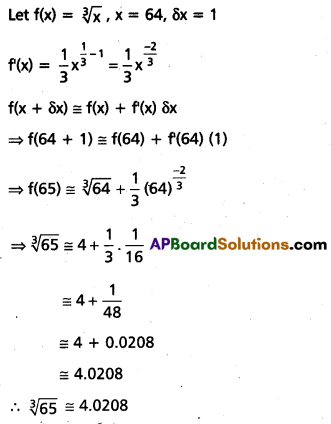
![]()
Question 10.
Verify Rolle’s theorem for sin x – sin 2x on [0, π].
Solution:
Let f(x) = sin x – sin 2x defined over [0, π]
Clearly f is contenuous on [0, π] and f is derivable on (0, π)
Also f(0) = sin 0 – sin 0 = 0
f(π) = sin π – sin 2π = 0 – 0 = 0
∴ f(0) = f(π)
∴ f satisfies all the conditions of Rolle’s theorem.
∴ Ǝ C ∈ (0, π) such that f'(c) = 0
f(x) = sin x – sin 2x
f'(x) = cos x – 2 cos 2x
f (c) = cos c – 2cos 2c
0 = cos c – 2(2cos2c – 1)
0 = cos c – 4 cos2c + 2
⇒ 4 cos2c – cos c – 2 = 0
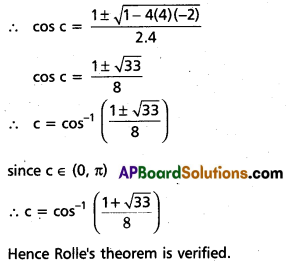
Section – B
(5 × 4 = 20 Marks)
II. Short answer type questions.
- Attempt ANY FIVE questions.
- Each question carries FOUR marks.
Question 11.
Find the equation of the locus of a point the difference of whose distances from (-5, 0) and (5, 0) in 8.
Solution:
A(5, 0), B(-5, 0) are the given points.
P(x, y) is any point on the locus.
Given condition is |PA – PB| = 8
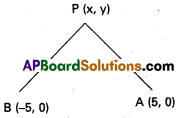
PA – PB = 8 ……… (1)
PA2 – PB2 = [(x – 5)2 + (y – 0)2] – [(x + 5)2 + (y – 0)2]
= x2 – 10x + 25 + y2 – x2 – 10x – 25 – y2 = -20x
(PA + PB) (PA – PB) = -20x
(PA + PB) 8 = -20x
PA + PB = –\(\frac{5}{2}\)x ……… (2)
Adding (1) and (2).
2PA = –\(\frac{5 x}{2}\) + 8 = \(\frac{-5 x+16}{2}\)
4PA = -5x + 16
16PA2 = (-5x + 16)2
16 [(x – 5)2 + y2] = (-5x + 16)2
16 [x2 – 10x + 25 + y2] = [-5x + 16]2
16x2 + 16y2 – 160x + 400 = 25x2 + 256 – 160x
9x2 – 16y2 = 144
Dividing with 144, locus of P is \(\frac{9 x^2}{144}-\frac{16 y^2}{144}\) = 1 i.e., \(\frac{x^2}{16}-\frac{y^2}{9}\) = 1
Question 12.
When the origin is shifted to (-1, 2) by the translation of axes find the transformed equation of x2 + y2 + 2x – 4y + 1 = 0.
Solution:
Here (h, k) = (-1, 2)
x = X + h ⇒ x = X – 1
y = Y + k ⇒ y = Y + 2
Given equation is x2 + y2 + 2x – 4y + 1 = 0
Now transformed equation is
(X – 1)2 + (Y + 2)2 + 2(X – 1) -4(Y + 2) + 1 = 0
⇒ X2 – 2X + 1 + Y2 + 4Y + 4 + 2X – 2 – 4y – 8 + 1 = 0
⇒ X2 + Y2 – 4 = 0
⇒ X2 + Y2 = 4
![]()
Question 13.
Find the equation of the straight lines passing through (1, 3) and
(i) parallel to
(ii) perpendicular to the line passing through the points (3, -5) and (-6, 1).
Solution:
Let A = (3, -5)
B = (-6, 1)
Equation of \(\overline{\mathrm{AB}}\) is
y – y1 = \(\frac{y_2-y_1}{x_2-x_1}\)(x – x1)
⇒ y + 5 = \(\frac{1+5}{-6-3}\)(x – 3)
⇒ -9y – 45 = 6x – 18
⇒ 6x + 9y + 27 = 0
⇒ 2x + 3y + 9 = 0
i) Equation or the straight line passing through (1,3) and parallel to \(\overline{\mathrm{AB}}\) is a (x – x1) + b(y – y1) = 0
⇒ 2(x – 1) + 3(y – 3) = 0
⇒ 2x – 2 + 3y – 9 = 0
⇒ 2x + 3y – 11 = 0
ii) Equation of the straight line passing through (1, 3) and perpendicular to AB is b(x – x1) – a(y – y1) = 0
⇒ 3(x – 1) – 2(y – 3) = 0
⇒ 3x – 3 – 2y + 6 = 0
⇒ 3x – 2y + 3 = 0
Question 14.
If f, given by :

is a continuous function on R, then find the values of k.
Solution:

Since f is a continuous function on R
∴ f is continuous at x = 1
\(\lim _{x \rightarrow 1-} f(x)\) = f(1) = \(\lim _{x \rightarrow 1_{+}} f(x)\) ……. (1)
\(\lim _{x \rightarrow 1^{-}} f(x)\) = 2
Also f(1) = k2(1) – k = k2 – k
From (1) = k2 – k = 2
⇒ k2 – k – 2 = 0
⇒ k2 – 2k + k – 2 = 0
⇒ k (k – 2) + 1 (k – 2) = 0
⇒ (k – 2) (k + 1) = 0
∴ k = 2 (or) – 1
Question 15.
Find the derivative of cos ax using first principle.
Solution:

Question 16.
The volume of a cube is increasing at a rate of 9 cubic centimeters per second. How fast is the surface area increasing when the length of the edge is 10 centimeters ?
Solution:
Let x be the length of the edge of the cube, V be its volume and S be its surface area. Then, V = x3 and S = 6x2. Given that rate of change of volume is 9 cm3/sec.

Question 17.
Find the lengths of subtangent subnormal at a point ‘t’ on the curve x = a(cos t + t sin t), y = a(sin t – t cos t).
Solution:
Equations of the curve are x = a (cos t + t sin t)
x = a (cos t + t sin t)
\(\frac{\mathrm{dx}}{\mathrm{dt}}\) = a(-sin t + t cos t) = at cos t dt
y = a (sin t – 1 cos t)
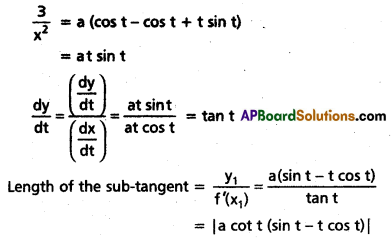
Length of the sub-normal = \(\frac{y_1}{f^{\prime}\left(x_1\right)}\) = \(\frac{a(\sin t-t \cos t)}{\tan t}\)
Length of the sub-normal = |y1.f'(x1)|
= |a(sint – tcos t) tan t
= |a tan t (sin t – t cos t|
Section – C
III. Long answer type questions :
- Attempt ANY FIVE questions.
- Each question carries SEVEN marks.
Question 18.
Find the ortho center of the triangle with the following vertices : (-2, -1), (6, -1) and (2, 5).
Solution:
Let A = (-2, -1); B = (6, -1); C = (2, 5)
Slope of \(\overline{\mathrm{BC}}\) = \(\frac{5+1}{2-6}\) = \(\frac{-3}{2}\)

Question 19.
Show that the equation : 2x2 – 13xy – 7y2 + x + 23y – 6 = 0 represents a pair of straight lines, also find the angle between them and the co-ordinates of the point of intersection of the lines.
Solution:
Here a = 2 f = \(\frac{23}{2}\)
b = -7 g = \(\frac{1}{2}\)
c = 6 h = –\(\frac{13}{2}\)
abc + 2fgh – af2 – bg2 – ch2
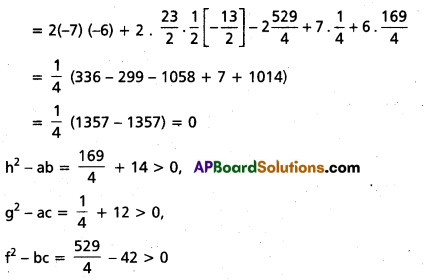
The given equation represents a pair of lines
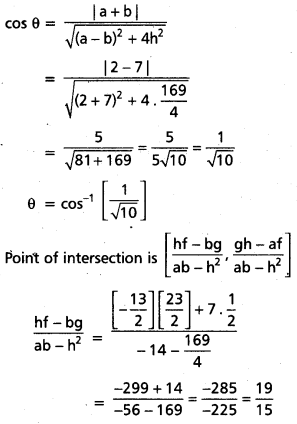
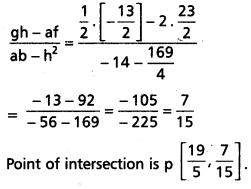
![]()
Question 20.
Show that the lines joining the origin to the points of intersection of the curve x2 – xy + y2 + 3x + 3y – 2 = 0 and the straight line x – y – \(\sqrt{2}\) = 0 are mutually perpendicular.
Solution:
Equation of the curve is Y
x2 – xy + y2 + 3x + 3y – 2 = 0 ……. (1)
Equation of AB is x – y – \(\sqrt{2}\) = 0
x – y = \(\sqrt{2}\)
\(\frac{x-y}{\sqrt{2}}\) = 2 ……. (2)

Homogenising, (1) with the help of (2) combined equation of OA, OB is

Question 21.
Show that the lines whose d.c’s are given by l + m + n = 0, 2mn + 3nl – 5lm =0 are perpendicular to each other.
Solution:
Given l + m + n = 0 ……. (1)
2mn + 3nl – 5lm = 0 ……… (2)
From (1), l = -(m + n)
Substituting in (2)
2mn – 3n(m + n) + 5m(m + n) = 0
2mn – 3mn – 3n2 + 5m2 + 5mn = 0
5m2 + 4mn – 3n2 = 0
\(\frac{m_1 m}{n_1 n_2}\) = \(-\frac{3}{5}\) ⇒ \(\frac{m_1 m_2}{-3}\) = \(\frac{n_1 n_2}{5}\) …… (1)
From (1), n = -(l + m)
Substituting is (2)
-2m (l + m) – 3l (l + m) – 5lm = 0
-2lm – 2m2 – 3l2 – 3lm – 5lm = 0
3l2 + 10lm + 2m2 = 0
\(\frac{l_1 l_2}{m_1 m_2}\) = \(\frac{2}{3}\) ⇒ \(\frac{l_1 l_2}{2}\) = \(\frac{m_1 m_2}{3}\) ….. (2)
From.(1) and (2) we get
\(\frac{l_1 l_2}{2}\) = \(\frac{m_1 m_2}{3}\) = \(\frac{n_1 n_2}{-5}\) = 1
l1l2 + m1m2 + n1n2 = 2k + 3k – 5k = 0
The two lines are perpendicular.
Question 22.
If y = tan-1\(\left[\frac{2 x}{1-x^2}\right]\) + tan-1\(\left[\frac{3 x-x^3}{1-3 x^2}\right]\) – tan-1\(\left[\frac{4 x-4 x^3}{1-6 x^2+x^4}\right]\) then \(\frac{d y}{d x}\) = \(\frac{1}{1+x^2}\)
Solution:
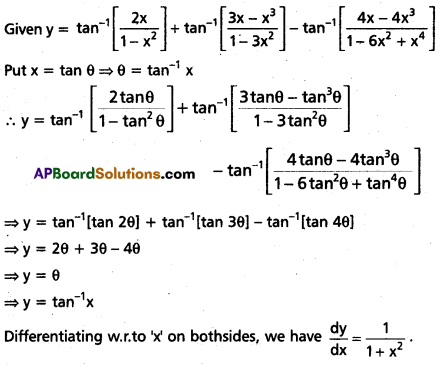
Question 23.
Show that the curves 6x2 – 5x + 2y = 0 and 4x2 + 8y2 = 3 touch each other at \(\left(\frac{1}{2}, \frac{1}{2}\right)\).
Solution:
Given curve equations are
6x2 – 5x + 2y = 0 ……. (1)
4x2 + 8y2 = 3 ……. (2)
Differentiating (1) w.r.to ‘x’ on both sides dy
12x – 5 + 2 \(\frac{d y}{d x}\) = 0
⇒ 2 \(\frac{d y}{d x}\) = 5 – 12x

∴ Given curves (1) & (2) touch each other at \(\left(\frac{1}{2}, \frac{1}{2}\right)\).
![]()
Question 24.
Find two positive numbers whose sum is 15 so that the sum of their squares is minimum.
Solution:
Let x, y be two positive numbers.
∴ x + y = 15
⇒ y = 15 – x
Let f(x) = x2 + y2
= x2 + (15 – x)2
= x2 + 225 – 30x + x2
= 2x2 – 30x + 225
f(x) = 4x – 30
For maxima or minima
f'(x) = 0
⇒ 4x – 30 = 0
⇒ 4x = 30
⇒ 2x = 15
⇒ x = \(\frac{15}{2}\)
f”(x) = 4
f”\(\left(\frac{15}{2}\right)\) = 4 > 0
∴ f has maximum at x = \(\frac{15}{2}\)
∴ y = 15 – \(\frac{15}{2}\) = \(\frac{30-15}{2}\) = \(\frac{15}{2}\)
∴ x = \(\left(\frac{15}{2}\right)\), y = \(\left(\frac{15}{2}\right)\)